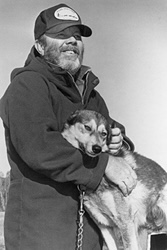Growing up, Gary Paulsen was one of my favorite authors. I wrote him a letter and he sent me back a photo with his autograph and a personalized letter. I still remember the moment when I received that in mail. It was a cool feeling that a role model took the time to send that. Sometimes, it is the little things in life that can stick with us.
This is the second post in the series about manliness in literature. If you haven’t done so, Read the first post, The Manliness of Jack London.

The Early Years
Gary Paulsen is an American author of young adult and children’s literature. He was born on May 17, 1939 in Minneapolis, Minnesota, and grew up in the suburbs. Paulsen was raised by his grandparents and had a difficult childhood marked by poverty and neglect. Despite these challenges, he found solace in books and began writing at a young age.
Paulsen worked a variety of odd jobs before settling into a career as a writer. He wrote his first novel, “Dancing Carl”, in the 1970s, and since then has written more than 200 books, including novels, memoirs, and nonfiction. He is best known for his adventure and survival stories, such as “Hatchet” and “The River”.
Paulsen’s writing often focuses on the wilderness and the challenges that come with surviving in harsh conditions. He has won several awards for his work, including the Newbery Honor and the Margaret A. Edwards Award. Paulsen’s books are widely read by children and young adults, and his stories often inspire a love of nature and the outdoors.
Personal Life
In addition to writing, Paulsen is an avid outdoorsman who has lived in remote cabins in the wilderness and has experience with dog sledding, cross-country skiing, and sailing. He has used these experiences to inform his writing and to inspire young readers to pursue their own adventures in nature.
At the age of 82, Gary Paulsen passed away on October 13, 2021 and his work continues to be popular with readers of all ages. He is considered a prominent figure in children’s literature and has made a lasting impact on the genre through his storytelling and his commitment to inspiring young people.
The Theme of Manliness
Gary Paulsen’s writing’s are about adventure and survival stories, whose characters are often rugged, resourceful, and independent with a strong connection to the land. Paulsen’s portrayal of manliness is less about physical strength and more about inner qualities such as determination, courage, and resourcefulness. In this blog post, we will explore how Paulsen’s writing portrays manliness, as well as the value of his portrayal for men today.
Paulsen often features characters who demonstrate manliness through self-reliance, toughness, and the ability to survive in harsh conditions. One example of this is Brian Robeson from Hatchet, who demonstrates courage and inner strength while surviving alone in the wilderness. This character serves as a prime example of self-reliance and resourcefulness in the face of danger. Additionally, there is a strong connection between manliness and self-reliance in Paulsen’s writing, with characters exhibiting a strong connection to the land and their ability to survive on their own. Other examples of characters who demonstrate courage and resourcefulness include Wil from Woodsong and Dave from Dogsong, both of whom face difficult challenges with bravery and determination.
Paulsen’s portrayal of manliness serves as an inspiration for men today to be independent and self-reliant. It encourages men to have courage and determination in the face of adversity by showing examples of characters who demonstrate these qualities in Paulsen’s writing. Additionally, Paulsen’s writing emphasizes the importance of resourcefulness and problem-solving skills in order to survive difficult situations. This teaches men valuable life lessons about manliness that can be applied to real-life situations.
Paulsen’s writing provides an important perspective on what it means to be a man in today’s world and serves as an important reminder that manliness is not just about physical strength but also about inner strength and resilience.
Leave a Reply